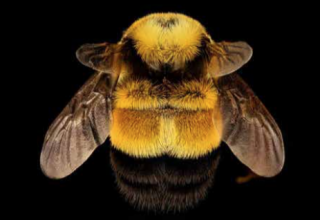Great Barrington Pollinator Action Plan: A Healthy Habitat for GB Bees and Others

With a global decline of pollinater species -- bees, butterflies, hummingbirds, moths -- the town's Agricultural Commission has finalized a Pollinator Action Plan to help support the local bee population. Why? Because three quarters of flowering plants ( from flowers to agricultural crops) rely on the pollinators to reproduce.
The Pollinator Action Plan [read here], developed by the Agricultural Commission, Department of Public Works and The Conway School in Northampton, along with public input -- proposes an interconnected pollinator habitat network throughout Great Barrington to ensure a healthy pollinator population. Small home-based gardeners, large-scale gardeners, schools, golf courses, businesses and institutions can take steps to preserve and improve pollination habitats, as can the the town at municipal properties, the report states. The effort is already aided by some 4,000 acres of active farmland in town. On Monday, Aug. 27, the Agricultural Commission discusses the report with the Select Board.
 "Anyone with a piece of land or a sidewalk strip can use this plan," the report states, and a collaborative town effort "can build a thriving, lively, poliinator-friendly community -- and inspire other communities to do so also."
"Anyone with a piece of land or a sidewalk strip can use this plan," the report states, and a collaborative town effort "can build a thriving, lively, poliinator-friendly community -- and inspire other communities to do so also."
The report urges the adoption of polices that miniized the sale and use of insecticides and urges residents and business owners to adopt several key practices:
- Avoid use of insecticides
- Avoid planting flowering plants that have been treated with synthetic insecticides
- Reduce mowing frequency
- Plant more bee-friendly flowers, trees and vegetables
- Focus on native plant species
The report cites Town Hall, the town's two libraries, cemeteries, the River Walk and Stanley Park as areas that have space and soil for additional pollinator-friendly plantings, along with hiking paths, trails and sidewalk grass strips on Main Street.
For their part, town residents can decrease lawn-mowing freqency (every three weeks) and maintain a grass height of not less than three inches, plant more flowers and "bumble bee gardens" and allow dandelions and other flowering weeds to flourish, can improve pollinator habitat. Reducing or eliminating pesticides also improves the pollinator population.
The report also includes recommended plantings friendly to polinators, safe weed and pesticide management applications and more.

